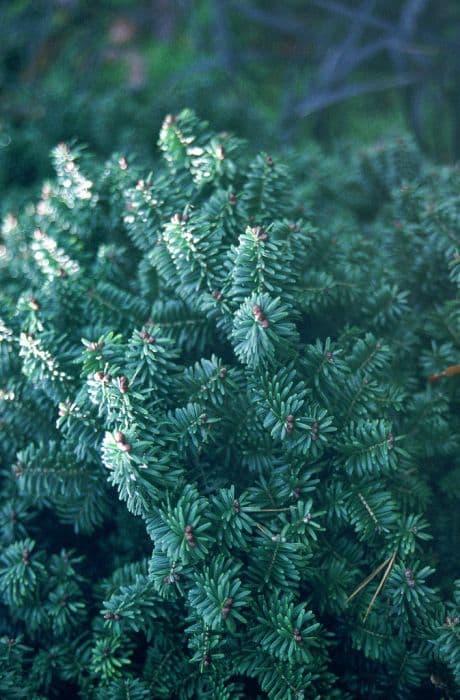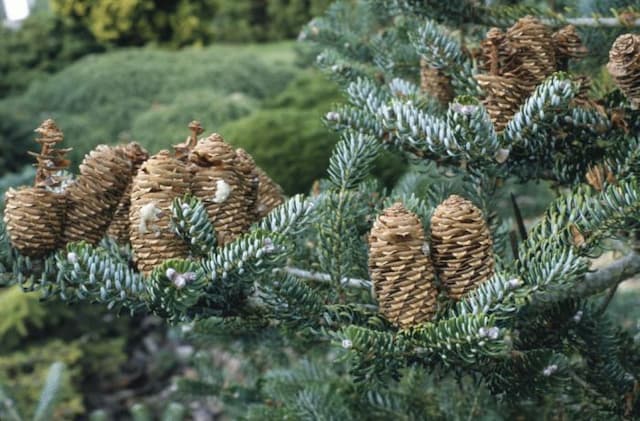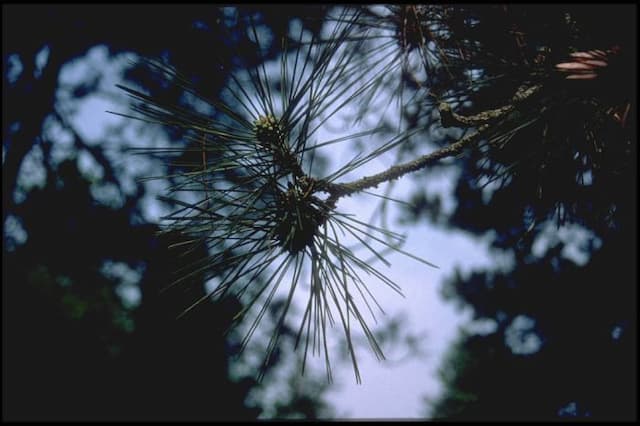Scots Pine Pinus sylvestris Aurea Group

ABOUT
The plant known as Scots Pine 'Aurea Group' is characterized by its distinct golden-yellow needles that are especially vibrant during the new growth in the spring. As the seasons change, the foliage transitions to a blue-green color, returning to the golden hue when winter approaches. The needles themselves are long and bundled in pairs. This conifer has a typical pine structure with a regular branching pattern that becomes more sparse and open near the top. The bark of the Scots Pine 'Aurea Group' shows a notable contrast, with a flaky, orange-brown appearance at the top, becoming more rugged and deeply fissured near the base. The tree often presents a tall, straight trunk. Throughout its growth, this plant will produce cones that start off green and mature to a pale brown. These cones are oval-shaped, often tilted to one side, with each scale ending in a small protuberance. The overall form of the Scots Pine 'Aurea Group' is classic and picturesque, making it a stunning feature in any landscape focused on spectacular seasonal shifts of color.
About this plant
 Names
NamesFamily
Pinaceae.
Synonyms
Scots Pine, Scotch Pine.
Common names
Pinus sylvestris Aurea Group.
 Toxicity
ToxicityTo humans
Scotch Pine, which the Pinus sylvestris Aurea Group is a variant of, is generally not considered toxic to humans. However, caution should be exercised as consuming parts of any plant not typically regarded as food can cause adverse reactions in some individuals. Ingesting pine needles or other parts of the pine tree in large quantities might lead to gastrointestinal irritation or discomfort. It's important to keep in mind that the essential oils present in the pine can be harmful if ingested in significant amounts, potentially leading to symptoms such as nausea, vomiting, or diarrhea. If you suspect poisoning, seek medical advice promptly.
To pets
Scotch Pine, as categorized in the Pinus sylvestris Aurea Group, is not broadly recognized as toxic to pets. Nonetheless, it’s generally advised to prevent pets from ingesting the plant, as the oils and resins within pine needles can be irritating to animals. Eating a small quantity of pine needles might cause minor gastrointestinal upset, such as vomiting or diarrhea, in pets. If substantial amounts are ingested, the risks include more severe problems like gastrointestinal obstruction or punctures. If you notice signs of poisoning or distress in your pet after contact with the plant, contact your veterinarian for guidance.
 Characteristics
CharacteristicsLife cycle
Perennials
Foliage type
Evergreen
Color of leaves
Green
Height
40 feet (12 meters)
Spread
20 feet (6 meters)
Plant type
Tree
Hardiness zones
3
Native area
Europe
Benefits
 General Benefits
General Benefits- Ornamental Value: This group of Scots pine is appreciated for its striking golden-yellow foliage, which adds color and visual interest to landscapes.
- Durable Wood: The Scots pine is known for its strong and resilient timber, which is valuable for construction and carpentry.
- Erosion Control: The species is often used in reforestation and for stabilizing soil, thus reducing erosion in vulnerable areas.
- Habitat Creation: Scots pines provide shelter and nesting sites for various bird species, supporting local biodiversity.
- Adaptability: Being a hardy species, the Scots pine can grow in a range of climates and soil types, which makes it versatile for different landscape uses.
- Shade Provision: As a large tree, it can provide significant shade in gardens and parks, creating cooler and more comfortable outdoor spaces.
 Medical Properties
Medical PropertiesThis plant is not used for medical purposes.
 Air-purifying Qualities
Air-purifying QualitiesThis plant is not specifically known for air purifying qualities.
 Other Uses
Other Uses- As a natural dye: Scots pine can be used to create dyes for coloring textiles or leathers, with varying parts of the plant offering different shades of color.
- Woodworking and carving: Due to its texture, Scots pine wood is suitable for detailed carving, and it's used by artisans to create ornamental objects or sculptures.
- Photographic subjects: Scots pine, especially the Aurea Group with its distinctive hues, is often used in photography for its striking appearance during different seasons.
- Sound insulation: The wood of Scots pine has properties that make it useful for sound insulation in construction, reducing noise levels effectively.
- Footwear manufacturing: Pine resins extracted from Scots pine are sometimes used in the production of shoes, as it can be incorporated into adhesives or as a waterproofing agent.
- Smoke flavoring agent: Wood chips from Scots pine are used in smoking foods to impart a distinct flavor commonly associated with traditional smoked cuisines.
- Fencing material: Scots pine wood is a common choice for outdoor fencing due to its durability and resistance to decay when properly treated.
- Christmas tree: Although more commonly known for other species, some Scots pines are also grown and used as Christmas trees during the holiday season.
- Sailing and rigging: Historically, the resin from Scots pine was used in caulking wooden ships and protecting rigging from the elements.
- Environmental art: Living Scots pines or their parts (like fallen branches) are used by environmental artists to create natural, site-specific installations and sculptures.
Interesting Facts
 Feng Shui
Feng ShuiThe Scots Pine is not used in Feng Shui practice.
 Zodiac Sign Compitability
Zodiac Sign CompitabilityThe Scots Pine is not used in astrology practice.
 Plant Symbolism
Plant Symbolism- Resilience and Endurance: The common name for Pinus sylvestris Aurea Group is Scots Pine. Scots Pine is known for its ability to thrive in tough environments and poor soils which symbolizes resilience and the power to endure challenging conditions.
- Longevity: Scots Pine can live for hundreds of years, conveying the symbolic meaning of longevity and timelessness.
- Steadfastness: With its sturdy trunk and evergreen foliage, Scots Pine exemplifies steadfastness and reliability, often associated with constancy and faithfulness.
- Purity: The Scots Pine’s needle-like leaves are evergreen, suggesting themes of purity and eternal life, echoing the trees' ability to remain unchanging and consistent.
- Rejuvenation: This tree is known for its regenerative properties, naturally symbolizing rejuvenation and the ability to renew oneself or start anew.
 Water
WaterScots Pine (Aurea Group) should be watered deeply and infrequently to encourage a strong root system. During the first growing season, water regularly to keep the soil evenly moist but not waterlogged, providing about 1 to 2 gallons per week depending on weather conditions. Once established, they are quite drought-tolerant and may only need watering during prolonged dry spells. In these cases, provide them with a deep watering every 2 to 4 weeks. Always check the soil moisture level before watering to ensure the tree does not become overwatered.
 Light
LightScots Pine (Aurea Group) thrives in full sun conditions. It should be planted in a location where it can receive at least six hours of direct sunlight daily. Avoid shady spots, as ample sunlight is crucial for the health and growth of this pine variety.
 Temperature
TemperatureScots Pine (Aurea Group) can tolerate a wide range of temperatures, enduring cold down to -40 degrees Fahrenheit and thriving in areas with seasonal changes. Ideally, the best temperature for growing Scots Pine is between 60 to 70 degrees Fahrenheit, though it will do well in temperatures that are typically found throughout its growing zones.
 Pruning
PruningScots Pine (Aurea Group) often requires minimal pruning. Prune to remove dead or damaged branches and to maintain shape. The best time to prune is during the dormant season, in late winter or early spring, before new growth starts. Aim to prune no more than once a year to minimize stress to the tree.
 Cleaning
CleaningNot needed
 Soil
SoilThe Scots Pine 'Aurea Group' thrives best in well-draining sandy loam with a pH range of 5.5 to 7.0. A mixture composed of one-third peat, one-third garden soil, and one-third sand or perlite provides an ideal soil condition for healthy root development and overall growth.
 Repotting
RepottingScots Pine 'Aurea Group' typically requires repotting every 2-3 years during its younger stages to accommodate root growth. As it matures, repotting can be done less frequently, every 4-5 years, or as needed when the root system outgrows the current container.
 Humidity & Misting
Humidity & MistingScots Pine 'Aurea Group' prefers to grow in outdoor environments where the ambient humidity mirrors natural conditions. It tolerates a wide range of humidity levels and requires no specific humidity control when planted in its natural outdoor habitat.
 Suitable locations
Suitable locationsIndoor
Ensure full sun, cool room, and good air circulation for indoor Scots Pine.
Outdoor
Plant in full sun, well-draining soil, and water deeply but infrequently.
Hardiness zone
3-7 USDA
 Life cycle
Life cycleThe life of Scots Pine 'Aurea', or Pinus sylvestris Aurea Group, begins with seed germination, often requiring a period of stratification to break dormancy. Seedlings develop a taproot and start establishing a distinctive conical shape. As it matures into a juvenile tree, it develops a thick, scaly bark and its once-dense branches start thinning out. During its adult phase, the tree's crown broadens and it can produce cones after 10-20 years, with male and female cones usually found on the same tree. Pollination occurs in spring, and the seeds mature over a period of 1.5-2.5 years before being released. The Scots Pine 'Aurea' can live for several hundred years, during which it continues its reproductive cycle, while the older trees eventually succumb to natural aging, environmental factors, or disease.
 Propogation
PropogationPropogation time
Spring to Summer
Propogation: The most popular method of propagating the Scots Pine 'Aurea Group' is through seed collection and sowing. The best time to collect seeds is in the fall when cones naturally mature and open, releasing the seeds. To propagate Scots Pine, you must first extract seeds from the cones which can be facilitated by keeping them in a warm, dry place until they open. After collecting the seeds, they should be sown in a cold frame or directly outdoors in the spring after the last frost. It is important to provide well-drained soil and adequate sunlight for germination, which may take several weeks. Seedlings need protection from extreme weather conditions and should be watered regularly until they are well established.









